Pass Ccrn Test Bank All 150 Questions
And Answers With Latest 2024-2025
You are doing bedside report of a patient that is receiving a set
rate of "renal dose dopamine". You notice that this is running via a
peripheral IV. The next thing you do is: - ANSWER ✔️ Check the
IV site for signs of infiltration.
You are a nurse starting your shift. You are doing a bedside
report with the off-going nurse, when you realize that the patient's
peripheral IV site looks sort of shiny. You check for a blood return,
and find there is none. Plus, you have difficulty flushing. The
patient states that the IV burns when you flush it. The NEXT thing
you do is: - ANSWER ✔️ Find out what was running through the
IV; if it was a vesicant, then the IV will need immediate care.
Nurse Ned is going to give his patient Pantoprazole, 20mg IV
push. He has already checked to verify that: Pantoprazole is
compatible with the running IV fluids, his patient is not allergic to
Pantoprazole, the IV tubing is current and has an IV push access,
and that the site is OK and patent. Nurse Ned has also made sure
that the pump running the IV fluids is working properly, and has
verified and calculated how quickly he will give the Pantoprazole.
Nurse Ned administered the Pantoprazole, and is preparing to
,move on to his next task. Before Nurse Ned leaves this patient,
what should he do next? - ANSWER ✔️ Release tubing clamps
A patient is scheduled to get a unit of Packed Red Blood Cells
(PRBCs) because of anemia of chronic disease. What is the
smallest sized IV catheter that can be used in this patient to
administer the blood? - ANSWER ✔️ 22 g
Intravenous Penicillin has been prescribed for a patient admitted
to the hospital for treatment of pneumonia. Prior to administering
the first dose of penicillin, the nurse should ask the patient: -
ANSWER ✔️ "Have you had a previous allergy to Penicillin?"
According to Crimlisk, Johnstone, and Sanchez (2009), the
mnemonic CATS PRRR helps nurses remember to routinely
check IV medications for: - ANSWER ✔️ Compatibilities,
allergies, tubing correct, site checked, pump safety checked, right
rate, release clamps, return and reassess the patient.
You have just assumed care of King Valium, a new patient to your
floor. He has a history of IV drug abuse, and is admitted with
endocarditis. The off-going nurse reported to you that Mr. Valium
has had fevers up to 103.4, has been alternating between chilling
,and sweating, and is complaining of feeling terrible. She
attempted to start an IV, but was unsuccessful, so the patient has
not yet had his first dose of IV antibiotic. You know that the first
thing you will need to do for Mr. Valium is: - ANSWER ✔️ Assess
the patient's arms for a possible IV spot. If there is a good spot,
start the IV. If there is not, then call in more experienced help.
John Deer is a 48-year old male who just had a leg amputation
performed 24 hours ago. He is having excruciating pain and
requests some pain medication. You bring the Morphine 2 mg to
his room to give him IVP, as ordered. Before administering the
medication to the patient, you assess his RIJ central line, and find
that it will flush, but there is no blood return from the first port you
check. The NEXT thing you will do is: - ANSWER ✔️ Reposition
the patient and check again for blood return.
A patient who was involved in a high-speed motor vehicle crash
has just arrived in the ED. You are the nurse who will be placing
the IV catheter. You choose which size catheter? - ANSWER ✔️
18 g because blood and IVF will need to be administered quickly.
A patient comes into the Emergency Department with abdominal
pain. The nurse has orders to start IV fluids and draw labs. The
, nurse inserts an 18 g IV into the patient's right antecubital area,
and immediately draws a "rainbow" of blood tubes that get sent to
lab. As soon as the nurse is finished collecting the labs, she
flushes the blood out of the line, hooks the IV fluids into the IV,
and sets the pump for the proper rate. The nurse did not formally
check the IV for patency (flush with 10 mL saline and check for a
blood return) because: - ANSWER ✔️ The nurse knew the IV
was patent because she was able to draw blood from it for labs.
A terminally ill patients states to the nurse "I can't do this
anymore". What is the nurse's best response? - ANSWER ✔️
"Please tell me more about what you can no longer do."
One of your co-worker friends reveals to you that she has recently
been having nightmares about her patients dying despite her
efforts to help them. You have noticed that she has been
extremely irritable, looks exhausted, and has made some
inappropriate patient-care decisions. You will do which of the
following to help her: - ANSWER ✔️ Make arrangements for you
both to go hiking together at least weekly.




